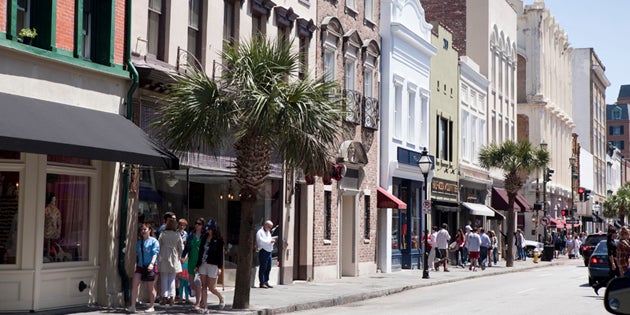King Street, located right next to the College of Charleston campus, has been named one of the 10 great streets in America by the American Planning Association.
RELATED: Read what the APA has to say about King Street.
You’d be hard pressed to find someone who doesn’t think King Street is great, but professors and students in the College’s Urban Studies Program explain the “why” behind King Street’s charm.
1. King Street is a human-scaled street.
There are few tall buildings and many different types of commercial, residential, recreational and spiritual settings.
“Places are the most powerful when they provide many different settings in which people can linger and create meaning,” explains political science professor Kevin Keenan, AICP. “King Street provides a venue for people to experience life in the ways that they find meaningful – whether it is seeking solace in a quiet church, romping through an open field with Frisbee wielding teens, viewing the latest art or strutting around with a recently purchased Gucci bag or belt.
RELATED: Watch 10 things to do in Charleston on a college student budget.
2. It invites pedestrians.
“I especially like King Street on Second Sundays when the street is made ‘pedestrian only,” sociology professor Debbie Auriffeille says. “It easily transforms into a mobility utopia that brings people together. Children are running around everywhere, you see people you know, and it makes Charleston feel like one big ‘neighborhood’ out for a barbecue.”
“King Street has a European feel, especially on Second Sundays,” notes history professor Richard Bodek. “Families walking down the street, cafes and vendors set up on the sidewalks.”
3. It is natural smart growth.
“King Street effectively combines residential development with commercial, without losing the overall feeling generated by years of history,” says Ron Hanna III, a graduate student in urban and regional planning. “King Street is smart growth, which has occurred naturally due to the geographic constraints of the Charleston peninsula.”
4. King Street blends seamlessly into its surroundings.
“King Street brings the vibrancy of the city right into the heart of the College of Charleston,” notes Kendra Stewart, director of the Joseph P. Riley Center for Livable Communities. “I love the subtle reminders King Street offers of what is happening on campus, such as the white dresses that students wear at graduation in store windows each April.”
 5. King Street reminds us of the past, with an eye to the future.
5. King Street reminds us of the past, with an eye to the future.
“King Street is where the historic architecture of the past provides the backdrop for present and future life,” says Barry Stiefel, historic preservation and community planning professor. “It is a captivating, four-dimensional place that encourages every generation’s appetite for social interaction.”
“King Street exudes how cities can evolve and stay true to their roots simultaneously,” says Deidre Carr, urban studies student.
6. King Street has energy.
“King Street’s food scene captures the dynamism and creative energy of the city,” notes history professor Lisa Pinley Covert. “There is so much to explore from the diverse offerings at the weekend farmer’s market to the upscale restaurants and the classic Lowcountry Sunday brunch spots.”
7. King Street fosters agglomeration economies.
Economics professor Chris Mothorpe notes, “King Street serves as the vital artery of the historic downtown Charleston area. Businesses and restaurants have located along the street to form an agglomerate that offers services to a diverse set of people and firms. This collection of institutions in close proximity to each other promotes even higher levels of social interactions.”
“I love the variety of King Street: Upper King with its design businesses, consignment stores, funky shops, and the mix of restaurants; Lower King and its antique stores, art galleries, and higher end stores; Marion Square, the centerpiece between the two arms of King, offering open space and a wonderful venue for music, art, occasional movies, and the Farmer’s Market,” says Melinda Lucka, urban studies faculty.






